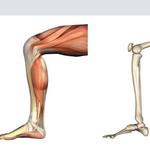
Niggling Lower Limb Injury
You are fit and healthy. You may not be a competitive athlete but you are training four or five times each week, so you're certainly not a couch potato. you eat sensibly and don't over do it when it comes to exercise or training. So why is it that you have that niggling lower limb injury?
We all know that ‘Your thigh bone connected from your knee bone, your knee bone connected from your leg bone, your leg bone connected from your ankle bone’ but many of us don’t know or forget that because they are all joined together, there is an intricate relationship between all the structures. A weakness in one place can cause a chain reaction leading to weakness or injury in another place further down the chain. It is very well known that female athletes (and you are an athlete if you are exercising on a regular basis) experience lower limb injuries at a disproportionate rate compared to male athletes. These injuries include anterior cruciate ligament (ACL) ruptures, patellofemoral pain, illiotibial band friction syndrome and stress fractures to the femur (thigh), pubic (hip), tibial (shin) and metatarsal (foot) bones.
There are structural differences between men and women. These differences probably mean that men and women have different movement patterns which may explain why women are more prone to lower limb injury than men. Women have wider, possibly anterior tilted hips both of which alter the angle that the femur extends. In female runners, studies have shown that the way in which the lower limbs move places a greater demand on the muscles in the lumbo-pelvic (core) region compared to the way a male’s lower limb moves when he runs. It has long been known that the knee may be a ‘victim of core instability’ with poor control from the core region resulting in poor alignment of the limbs during athletic activity and general poor stability in the legs. But it is not just the knee that is affected by poor core control. The list of common injuries above illustrates that many structures can be affected and cause major issues.
Stabilisation of the trunk and spine by the core muscles provides a solid foundation for the development of movement to the limbs, which results in co-ordinated movement patterns. An unstable core means that the development of movement at the hip is inappropriate leading to an inappropriate transmission of movement forces down the limbs. The limbs then do not move in a stable fashion and hence injury occurs.
So what do you do about it? If you have an injury it would be a good idea to get it seen to if you haven’t already. Find a physio and get treatment, although it is important to note that you may not be covered by ACC if your injury is an overuse problem. If you know your core is not particularly strong and you are doing a lot of running, cycling, skiing, snowboarding or other lower body movements then you need to initiate a core stability programme. Core stability is easy to improve and any gym instructor should be able to direct you toward a series of exercises that you can do either as a whole session or as part of other sessions you may already be doing. Core stability does not need to be done in the gym. You do not even need any equipment to do core stability work. You can do it while sitting in front of the TV in the evenings especially if you are thinking to yourself that you’re already pushed for time with all the responsibilities of training/working/family that you juggle on a daily basis. Flick through your old copies of Femme, or order a few back issues if you don’t have a pile gathering dust like I do, and put together your own routine. A regular dose of core training will make a huge difference to your stability with the added bonus of a flatter midsection!
Most of the research available about the core stability of female athletes indicates that women are pretty strong with prone exercises (lying flat or holding a bridge position) and crunch type movements but are weak in the side bridge (Figure 1) position. Additionally, women are notoriously weak in the gluteals (butt) which leads to the knees caving in on foot impact with ground (Figure 2) and a tendency for the thigh to rotate inwards during running. Your core stability programme should therefore include exercises that work the oblique muscles of the abdomen and some form of squatting type movement to strengthen the gluteals, in particular gluteus medius which helps to keep the thigh (and thus knees) from rolling inward.
What is patellofemoral pain?
Pain in the front of the knee or under the knee-cap that occurs with and without exercise. Pain is worse when the knee is maintained in a flexed position for prolonged periods e.g. while watching a movie, driving the car for long periods or sitting at a desk.
What is illiotibial band friction syndrome?
Most commonly an overuse injury but can occur as an acute injury due to, for example, a sudden change in running surface (soft to hard, smooth to uneven). The illiotibial band (ITB) extends from the hip down to just below the knee on the outer part of the thigh. It crosses over a bony point (the lateral epicondyle) on the thigh before it finally attaches onto the tibia and it is at this point that excessive friction can cause injury. Pain is usually on the outer part of the knee but can extend up into the hip. Pain usually occurs after a pain-free start to exercise and downhill running increases the pain. Pain with walking occurs as the syndrome progresses.
